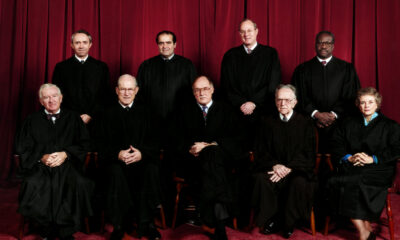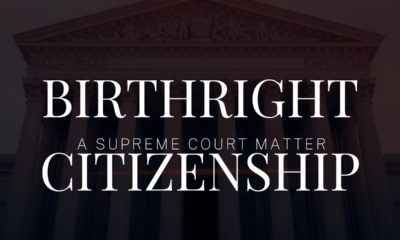Constitution
Redistricting in South Carolina – missed opportunity
Today the Supreme Court decided yet another redistricting case, in which liberal Democrats challenged a map mostly Republican legislators drew. The court held – mercifully – that map challengers may not assert racial prejudice in district mapmaking solely by reason of whether a district line passed to north or south (or east or west, etc.) of a number of white or nonwhite neighborhoods. Partisan politics governs redistricting, and the Court reiterated its determination not to judge a partisan exercise by a political body. That didn’t satisfy the Liberal Bloc, whose members insisted that South Carolina’s Republican Conferences used race as a proxy for likely partisan leanings. And that makes zero sense, as the Court held and as anyone can see who applies valid formal logic. But the Court also missed an opportunity to get itself and the lower courts out of the redistricting game completely.
The key redistricting case
The case was titled Alexander v. S.C. State Chap. NAACP, 602 U.S. ____ (2024) (Docket No. 22-807). State Senator Thomas C. Alexander (R-Walhalla) is the President of the South Carolina Senate. To make his role more interesting, shortly before the 1996 election cycle he switched parties, from Democrat to Republican.
After the 2020 Census, South Carolina had to redraw its U.S. Congressional districts, not because South Carolina gained or lost people (it didn’t), but because large numbers of people had moved. At issue were two neighboring Districts, 1 and 6. District 6 is the only safe Democratic seat in the South Carolina House delegation. District 1 was not so safely Republican in the Election of 2018 – Trump’s Midterm. But with Trump on the ballot, Republicans retook District 1. Then with the Census, Republicans saw a chance to make District 1 a safe, not merely a leaning, Republican seat.
To do that, Republicans actually reunified several counties that, ten years ago, the legislature had split between the two districts. They also moved several Democratic neighborhoods from District 1 to 6. Where the Democrats saw their chance at a challenge, is that those Democratic neighborhoods were predominately black. So the South Carolina NAACP, and one token named voter, sued, alleging racial gerrymandering and vote dilution. A three-judge District Court panel found for the challengers, after a nine-day trial with five expert witnesses.
How the Supreme Court voted and held
Mr. Alexander, as Senate President, appealed directly to the Supreme Court, not to the Fourth Circuit Court of Appeals.Readers can read the 104-page opinion, concurrence and dissent, here.
The Originalist and Moderate Blocs both voted, as their full memberships, to reverse the key holding of the District Court. As one might expect, the Liberal Bloc voted with equal unanimity to affirm the lower court. Justice Samuel A. Alito wrote for the majority, and Justice Clarence Thomas wrote a concurring opinion. (He and Alito didn’t quite agree on all particulars.) Justice Elena Kagan wrote the dissenting opinion.
Justice Alito observed two principles that remain in conflict. On one hand, the Supreme Court wants itself and the lower courts to stay out of partisan politics. A State legislature is an inherently political body, and may serve the partisan interests of its majorities with almost-complete freedom. On the other hand, a legislature may not primarily seek segregation of the races, or dilution of their votes.
Justice Alito held that the challengers, contrary to what the District Court held, plainly did not prove either “racial gerrymandering” (i.e., segregation) or vote dilution. He thoroughly discredited the challengers’ four expert witnesses calling them out for such logical fallacies as lack of denominators. In the end he found no evidence for segregation or vote dilution. Then, with fellow Originalist Neil Gorsuch and all the Moderates, he remanded the case for consideration of precedents under the Voting Rights Act.
Support for the reasoning
To resolve the “tension” between protection of partisan decision making and prohibition of racial decision making, the Supreme Court requires anyone bringing racial “gerrymandering” or vote-dilution claims to disentangle racial from political considerations. The problem, which Alito considered obvious, is that racial and partisan advantage go together. Blacks as a group have historically voted 80 to 90 percent Democratic. So if a mapmaker looks at voting history, chances are that he will draw a district boundary around a black neighborhood solely by reason of how they habitually vote. That, said Justice Alito, is perfectly acceptable. Moreover it is for the challenger to prove instead that the mapmakers sought to hold black voting strength to an arbitrary set point.
Predictably, Justice Kagan would assert that race became a proxy for voting behavior. This makes no sense. One can determine voting behavior in South Carolinadirectly,by examining how people in certain precincts vote in primaries. County Registrars of Elections can easily determine how many Republican or Democratic ballots they issue in primaries. (No State permits one to vote in more than one Party primary in the same day. South Carolina does not have “jungle primaries” with all candidates on the same ballot, as California has.) So no legislature needs to count racial numbers to achieve a partisan advantage. And if the racial and partisan mix happens to correlate, that reflects the tribalism of voters. (Which will not necessarily hold in future; more on that below.)
The missed opportunity
But Justice Thomas, in his concurrence, criticized Justice Alito on one point. How many more such cases, he asks perhaps with a sigh, must the Supreme Court waste its time with, before finally declaring that the Court should stay out of the racial mix of districts, and perhaps invalidate the Voting Rights Act of 1965?
In fact, racial segregation and vote dilution result from diametrically opposite actions. To segregate the races by district means to draw as many nonwhites as possible into their own district. They can elect their own representatives as they please, but they have no say in picking the rest of the State’s delegation. On the other hand, to dilute votes requires scattering nonwhite neighborhoods as nonwhite islands in white seas. When this happens, nonwhites might never have a chance to elect a nonwhite to represent them.
So how can even a bad-hearted legislature do both at once? Logically, it can’t.
In fact Justice Thomas made abundantly clear that he regards such cases as worse than a waste of time:
In my view, the Court has no power to decide these types of claims. Drawing political districts is a task for politicians, not federal judges. There are no judicially manageable standards for resolving claims about districting, and, regardless, the Constitution commits those issues exclusively to the political branches.
The Court’s insistence on adjudicating these claims has led it to develop doctrines that indulge in race-based reasoning inimical to the Constitution. As we reiterated last Term, “‘[o]ur Constitution is color-blind.’” Students for Fair Admissions, Inc. v. President and Fellows of Harvard College, 600 U. S. 181, 230 (2023) (quoting Plessy v. Ferguson, 163 U. S. 537, 559 (1896) (Harlan, J., dissenting)). A colorblind Constitution does not require that racial considerations “predominate” before subjecting them to scrutiny. Nor does it tolerate groupwide judgments about the preferences and beliefs of racial minorities. It behooves us to abandon our misguided efforts and leave districting to politicians.
Justice Thomas’ reasoning strikes CNAV as inarguable and incontrovertible. How do you judge gerrymandering or vote dilution? Not one clause in the Constitution gives a clue. Instead, notes Thomas, the Constitution authorizes Congress, and only Congress, to decide what’s fair and what’s unfair in this regard.
Furthermore, everyone should recognize what Democrats really want: proportional representation by party. That result is consistent with their National Popular Vote Compact to eliminate the Electoral College.
Why racial calculations in redistricting make no sense
Regarding the “correlation” between race and politics, that either exists, or doesn’t exist. If it exists, then of course Party members will shut out members of races who never vote as they do. Nonwhites shut out whites, the same as whites shut out nonwhites. And you don’t see whites complain – mostly because too many editorialists would consider that worse than rude.
But suppose it does not exist – or suppose, even better from a civilizational standpoint, it disappears? Then how does it avail, behoove, or befit either Party to shut out possible constituents? Worth remembering is that Democrats, not Republicans, retain contempt for nonwhites, even among their ideological fellow travelers. These are the White Liberals. You remember who got wise to them first? Malcolm X, that’s who.
In point of fact, Donald J. Trump made nonwhites consider abandoning the Democratic Party that has long pandered to them. The judge trying Trump’s New York indictment, to quote a hilariously silly and foolish remark by Rep. Alexandria Ocasio-Cortez (D-N.Y.), has clamped a figurative “ankle monitor” on Trump, effectively confining him to the Five Boroughs for days at a time.
In answer, Trump has campaigned actively in New York City! He did it first in Harlem (Harlem!!!), and is doing it now in the South Bronx. The results, thus far, stagger the imagination.
A better way
Justice Thomas is right to urge the Court to get out of redistricting. The Constitution says nothing abouthow legislatures may draw districts. The only grounds to infer any authority for the courts to adjudicate racial claims, might be one of the late Justice William O. Douglas’ “penumbras” that “emanate” from certain texts of the Constitution. In this case, the relevant passage might be Amendment XIV Section 2, and then Amendment XV, which supersedes that. And as Donald J. Trump is now showing, the racial division between the two parties is now obsolete.
But the Framers did not give a sound basis for determining neighborly relationships among people within a State. To paraphrase an even earlier Supreme Court opinion, “resort must be had elsewhere” to determine a proper basis for redistricting. Why not use the boundaries for smaller governmental units? CNAV discussed that two and a half years ago, and reiterates the principles here. Legislative district boundaries should never cross county (or parish) lines, or city, town, or other corporate limits. A unit too big for one Representative might split into two or three. But no Representative should represent parts of different counties. Furthermore, the cherished “one person, one vote” principle appears nowhere in the Constitution. If that stands in the way of, for example, having one Senator from each unit, then end it.
Justice Thomas is right about another thing: it’s time to ditch the Voting Rights Act and enact this kind of neighborly principle for legislative districts.
Terry A. Hurlbut has been a student of politics, philosophy, and science for more than 35 years. He is a graduate of Yale College and has served as a physician-level laboratory administrator in a 250-bed community hospital. He also is a serious student of the Bible, is conversant in its two primary original languages, and has followed the creation-science movement closely since 1993.
-

 Civilization4 days ago
Civilization4 days agoDC Pipe Bomb Arrest Raises Questions About Christopher’s Wray’s FBI
-

 Civilization5 days ago
Civilization5 days agoThe Legal Logic Behind U.S. Operations Against Narco-Terrorist Networks
-

 Executive5 days ago
Executive5 days agoNewsom’s ‘National Model’ for Homeless Wracked by Fraud
-

 Executive4 days ago
Executive4 days agoWhen You’re in a Hole, Stop Digging
-

 Education3 days ago
Education3 days agoWaste of the Day: Taxpayers Subsidize Football Coach Severance
-

 Executive2 days ago
Executive2 days agoWaste of the Day: Obamacare Failed Test, Approved Fraudulent Subsidies
-

 Civilization3 days ago
Civilization3 days agoPence Calls on Trump To Fire RFK Jr Over Abortion Drug
-

 Executive4 days ago
Executive4 days agoWaste of the Day: Feds Pay Nonprofits That Sue the Government










